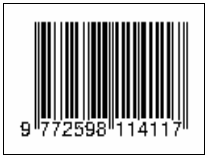Estimating Food Elasticities for Urban and Rural Households in Indonesia
Abstract
Full Text:
PDFReferences
Amanaturrohim, H, and Widodo, J. 2016. Pengaruh Pendapatan dan Konsumsi Rumah Tangga terhadap Kesejahteraan Keluarga petani Penggarap Kopi di Kecamatan Candiroto, kabupaten Temanggung. Econ. Educ. Anal. J. 5(2):468–479.
Arivelarsan, T., and Sekar, C. 2019. Food Consumption Pattern of Cauvery Delta Region of Tamil Nadu-An Application of Quadratic Almost Ideal Demand System (QUAIDS). Economic Affairs 64(2): 361–66.
Arthatiani, F.Y., Kusnadi, N. and Harianto 2018. Analisis Pola Konsumsi dan Model Permintaan Ikan Menurut Karakteristik Rumahtangga Di Indonesia (Analysis of Fish Consumption Patterns and Fish Demand Model Based on Household’s Characteristics in Indonesia). Journal sosek KP 13(021): 73–86.
Banks, J., Blundell, R., and Lewbel, A. 2007. The Review of Economics and Statistics. The Review of Economics and Statistics 79(4): 527–39.
Bett, H. K., Musyoka, M.P., Peters, K.J. and Bokelmann, W. 2012. Demand for Meat in the Rural and Urban Areas of Kenya: A Focus on the Indigenous Chicken. Economics Research International 2012: 1–10.
Deaton, A. and Muellbauer, J. 1980. An Almost Ideal Demand System. The American Economic Review 70(3): 312–26.
Erhabor, P.O.I., and Ojogho, O. 2011. Demand Analysis for Rice in Nigeria. Journal of Food Technology 9(2): 66–74.
Gostkowski, M. 2018. Elasticity of Consumer Demand: Estimation Using a Quadratic Almost Ideal Demand System. Econometrics 22(1): 68–78.
Kumar, P., Kumar, A., Parappurathu, S., and Raju, S.S. 2011. Estimation of Demand Elasticity for Food Commodities in India. Agricultural Economics Research Review Vol. 24 January-June 2011: pp 1-14.
Laili, F., and Anindita, R. 2018. Household Level in East Java: Implementation of Quadratic. Jurnal Ekonomi Pertanian dan Agribisnis (JEPA) 2: 119–28.
Lantican, F.A., Sombilla, M.A. and Quilloy, K.P. 2013. Estimating the Demand Elasticities of Rice in the Philippines. Philippines: SEARCA.
Malian, A.H., Mardianto, S., and Ariani, M. 2016. Faktor-Faktor yang Mempengaruhi Produksi, Konsumsi Dan Harga Beras Serta Inflasi Bahan Makanan. Jurnal Agro Ekonomi 22(2): 119.
Miranti, A., Syaukat, Y., and Harianto, NFN. 2016. Pola Konsumsi Pangan Rumah Tangga di Provinsi Jawa Barat. Jurnal Agro Ekonomi 34(1): 67–80.
Nugroho, S., and Wardhani, S. 2016. Pola Permintaan Daging Tingkat Rumah Tangga di Indonesia: Analisa Data Mikro 2013 (Household Level Meat Demand Pattern in Indonesia : Micro Data Analysis 2013). Jurnal ekonomi dan pembangunan Indonesia 16(1): 47–58.
Oyinbo, O., Omelehin, R.A, and Abdulsalam, Z. 2013. Analysis of the Demand for Rice in Kaduna State, Nigeria. Agris online Papers in Economics and Informatics V(3): 45–53. https://www.researchgate.net/publication/281120874_Analysis_of_the_Demand_for_Rice_in_Kaduna_State_Nigeria
Pontoh, R., Palar, S.W., and Maramis, MTB. 2016. Permintaan dan Penawaran Beras di Indonesia (Pada Tahun 2003–Tahun 2013 ). Jurnal Berkala Ilmiah Efisiensi 16(04): 833–44. https://ejournal.unsrat.ac.id/index.php/jbie/article/view/13748
Setiawan, E., Hartoyo, S., Sinaga, B.M., and Hutagaol, M.P. 2016. Dampak Kebijakan Input, Output dan Perdagangan Beras terhadap Diversifikasi Pangan Pokok. Jurnal Agro Ekonomi 34(2): 81–104.
Virgantari, F. 2012. Analisis Permintaan Produk Perikanan di Indonesia: Suatu Studi Cross-Sectional. [Disertasi]. Fakultas Ekonomi dan Manjemen. Departemen Ekonomi Pertanian. IPB : Bogor
Wijayati, P.D., Harianto, N.F.N., and Suryana, A. 2019. Permintaan Pangan Sumber Karbohidrat di Indonesia. Analisis Kebijakan Pertanian 17(1): 13–26.
Yuliana, R. 2018. Permintaan Pangan Dan Perubahan Tingkat Kesejahteraan Rumahtangga di Indonesia. [Disertasi] Fakultas Ekonomi dan Manajemen. Departemen Ekonomi Pertanian. IPB: Bogor.
Refbacks
- There are currently no refbacks.








